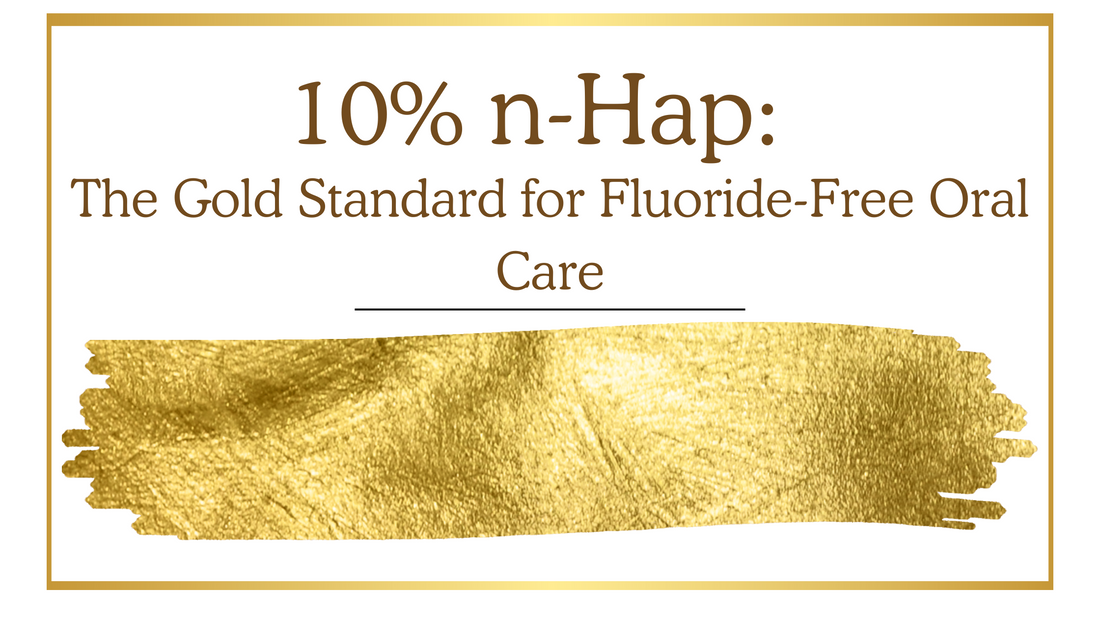
10% n-HA: The Gold Standard for Fluoride-Free Oral Care
Share
Why 10% Nano-Hydroxyapatite is the Gold Standard for Oral Care
When it comes to fluoride-free oral care, nano-hydroxyapatite (n-HA) has emerged as a game-changer. But why is 10% the optimal concentration? Science has shown that this specific amount provides the best balance of remineralization, protection, and whitening—making it the gold standard for strengthening enamel naturally.
The Science Behind 10% n-HA
Nano-hydroxyapatite is a biomimetic mineral, meaning it closely resembles the hydroxyapatite found in human teeth and bones. Because of its structural similarity, it integrates seamlessly with enamel to repair microdamage and restore lost minerals. But studies have found that a 10% concentration is where it truly shines.
1. Maximum Remineralization Power
✔ Research shows that 10% n-HA is the ideal concentration for effectively remineralizing enamel and dentin. It fills microcracks in enamel, restoring mineral density and strengthening teeth against acid attacks from food, drinks, and bacteria.
✔ Lower concentrations (e.g., 5%) still provide benefits, but they may not be as effective in repairing enamel damage.
✔ Higher concentrations (>10%) don’t necessarily offer additional remineralization benefits and can make formulations unnecessarily costly.
2. Comparable to Fluoride in Cavity Prevention
✔ Studies have demonstrated that 10% n-HA is just as effective as fluoride in preventing cavities, offering a non-toxic alternative for those looking to avoid fluoride.
✔ Unlike fluoride, which chemically bonds to teeth, n-HA physically replaces lost minerals—reinforcing enamel without altering its natural structure.
3. Forms a Protective Barrier Against Plaque & Acid
✔ At 10% concentration, n-HA creates a smooth, protective layer over teeth that reduces plaque buildup and shields enamel from acidic erosion.
✔ This barrier function helps prevent demineralization while keeping your teeth naturally strong and resilient.
4. Effective Sensitivity Relief
✔ One of the biggest advantages of nano-hydroxyapatite is its ability to seal exposed dentin tubules, which are responsible for tooth sensitivity.
✔ 10% n-HA is proven to significantly reduce sensitivity, making it ideal for those with sensitive teeth who want a fluoride-free solution.
5. The Best Natural Whitening Solution
Most whitening toothpastes rely on abrasive particles or harsh chemicals like hydrogen peroxide, which can weaken enamel over time. n-HA whitens differently: ✔ Fills in surface imperfections, making enamel smoother and more reflective, resulting in a naturally brighter smile. ✔ Rebuilds mineral density, preventing discoloration from enamel erosion. ✔ Gentle & Non-Abrasive, making it safe for long-term use.
6. Proven Safety: Biomimetic & Does Not Cross the Blood-Brain Barrier
✔ Scientific studies confirm that nano-hydroxyapatite does not penetrate the blood-brain barrier, ensuring it remains safe for long-term use without neurotoxic concerns.
✔ Because n-HA is composed of calcium and phosphate—the very same minerals that make up enamel and bone—it is naturally biocompatible and non-toxic. Unlike synthetic chemicals, it works in harmony with the body’s natural processes, making it a safer alternative to fluoride.
The Bottom Line: 10% is the Sweet Spot
With decades of research backing its efficacy, a 10% concentration of nano-hydroxyapatite is the perfect balance of safety, effectiveness, and cost-efficiency. It provides maximum remineralization, cavity prevention, sensitivity relief, and whitening—without the risks associated with fluoride.
If you’re looking for a fluoride-free toothpaste that truly works, choosing one with 10% nano-hydroxyapatite ensures your teeth get the best care possible!
Ready to experience the benefits of 10% n-HA? Try Smart Charlie’s Toothpaste today!
References
https://pmc.ncbi.nlm.nih.gov/articles/PMC10562112/
https://pmc.ncbi.nlm.nih.gov/articles/PMC8432723/
https://www.researchgate.net/publication/26268434_Effect_of_nano-hydroxyapatite_concentration_on_remineralization_of_initial_enamel_lesion_in_vitro
https://www.theunorthodoc.com/main-blog/nano-hydroxyapatite-the-10-difference


